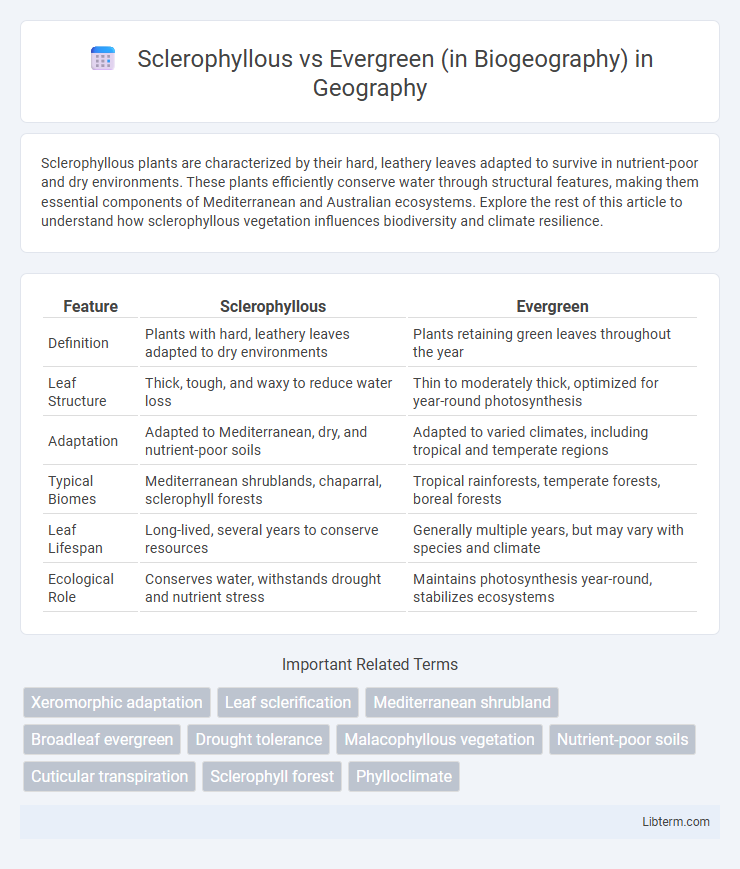Sclerophyllous plants are characterized by their hard, leathery leaves adapted to survive in nutrient-poor and dry environments. These plants efficiently conserve water through structural features, making them essential components of Mediterranean and Australian ecosystems. Explore the rest of this article to understand how sclerophyllous vegetation influences biodiversity and climate resilience.
Table of Comparison
| Feature | Sclerophyllous | Evergreen |
|---|---|---|
| Definition | Plants with hard, leathery leaves adapted to dry environments | Plants retaining green leaves throughout the year |
| Leaf Structure | Thick, tough, and waxy to reduce water loss | Thin to moderately thick, optimized for year-round photosynthesis |
| Adaptation | Adapted to Mediterranean, dry, and nutrient-poor soils | Adapted to varied climates, including tropical and temperate regions |
| Typical Biomes | Mediterranean shrublands, chaparral, sclerophyll forests | Tropical rainforests, temperate forests, boreal forests |
| Leaf Lifespan | Long-lived, several years to conserve resources | Generally multiple years, but may vary with species and climate |
| Ecological Role | Conserves water, withstands drought and nutrient stress | Maintains photosynthesis year-round, stabilizes ecosystems |
Introduction to Sclerophyllous and Evergreen Plants
Sclerophyllous plants, characterized by hard, leathery leaves with thick cuticles, are adapted to environments with nutrient-poor soils and seasonal droughts, commonly found in Mediterranean climates and Australia. Evergreen plants retain their foliage year-round, allowing continuous photosynthesis and adaptability to a range of climates from tropical rainforests to temperate zones. Both plant types play crucial roles in biogeographical studies due to their distinct adaptations that influence ecosystem structure, biodiversity, and resilience to environmental stressors.
Defining Sclerophyllous Vegetation
Sclerophyllous vegetation is characterized by hard, leathery leaves adapted to dry, nutrient-poor soils, commonly found in Mediterranean and subtropical climates. This type of vegetation contrasts with evergreen plants by its specific adaptation to withstand drought and fire, featuring thick cuticles and reduced stomatal openings. Sclerophyllous ecosystems play a crucial role in biogeography by supporting biodiversity in regions with seasonal drought and poor soil fertility.
Characteristics of Evergreen Vegetation
Evergreen vegetation in biogeography is characterized by plants that retain their leaves throughout the year, enabling continuous photosynthesis and adaptation to stable environments with moderate to high rainfall. These plants typically possess thick, waxy leaves that reduce water loss and are often found in tropical and subtropical regions, supporting diverse ecosystems. Evergreen species contribute to maintaining soil stability, carbon sequestration, and providing consistent habitat and food sources for various fauna.
Biogeographical Distribution Patterns
Sclerophyllous vegetation predominantly occurs in Mediterranean climates characterized by hot, dry summers and mild, wet winters, notably in regions such as the Mediterranean Basin, parts of Australia, California, and South Africa. Evergreen plants, with their year-round leaf retention, are widespread across diverse biomes including tropical rainforests, temperate forests, and boreal zones, reflecting adaptation to various climatic conditions from moist tropics to cold temperate areas. The distinct biogeographical distribution patterns of sclerophyllous and evergreen species highlight their evolutionary responses to specific environmental pressures such as water availability, fire regimes, and soil nutrient levels.
Environmental Adaptations and Climate Influence
Sclerophyllous vegetation, characterized by hard, leathery leaves, is adapted to nutrient-poor soils and frequent droughts, thriving in Mediterranean-type climates with hot, dry summers and mild, wet winters. Evergreen forests maintain their foliage year-round, favoring stable, humid environments such as tropical rainforests or temperate zones with consistent precipitation, allowing for continuous photosynthesis and nutrient cycling. Climate factors like seasonal water availability and temperature fluctuations critically influence the distribution and physiological adaptations of sclerophyllous versus evergreen biomes.
Soil Requirements and Nutrient Cycling
Sclerophyllous vegetation typically thrives on nutrient-poor, acidic, and well-drained soils, relying on slow nutrient cycling adapted to conserve resources in dry environments. Evergreen plants, often found in richer, more stable soils, promote faster nutrient cycling through continuous leaf litter decomposition and nutrient release. The contrasting soil requirements and nutrient cycling processes between sclerophyllous and evergreen vegetation influence ecosystem productivity and carbon storage in their respective biogeographic regions.
Ecological Roles and Biodiversity
Sclerophyllous and evergreen vegetation types play critical ecological roles by enhancing habitat complexity and supporting diverse faunal communities in their respective biogeographical regions. Sclerophyllous plants, adapted to nutrient-poor soils and periodic droughts, contribute to fire resistance and soil stabilization, fostering unique biodiversity hotspots especially in Mediterranean and Australian ecosystems. Evergreen species maintain year-round photosynthesis, promoting continuous energy flow and carbon sequestration in tropical and temperate forests, which sustains high species richness and ecological resilience.
Comparative Resilience to Fire and Drought
Sclerophyllous vegetation, characterized by hard, leathery leaves, exhibits greater resilience to fire and drought due to its thick cuticles and efficient water retention capabilities compared to evergreen species with softer foliage. These adaptations enable sclerophyllous plants to survive frequent wildfires and prolonged dry spells common in Mediterranean and xeric biomes. Evergreen species tend to be more vulnerable to intense drought and fire stress due to higher water demand and less protective leaf structures.
Human Impact and Conservation Concerns
Sclerophyllous vegetation, adapted to nutrient-poor soils and fire-prone environments, faces threats from urban expansion, agriculture, and frequent fires intensified by human activity, leading to habitat fragmentation and loss of native biodiversity. Evergreen forests, crucial for carbon sequestration and habitat stability, suffer from deforestation, logging, and climate change impacts, causing reduced species diversity and ecosystem resilience. Conservation efforts must prioritize habitat restoration, sustainable land management, and protection policies to mitigate human-induced pressures on both vegetation types and preserve their ecological functions in global biogeographic zones.
Summary: Key Differences in Biogeographic Context
Sclerophyllous vegetation, characterized by hard, leathery leaves, primarily adapts to nutrient-poor, dry Mediterranean climates, whereas evergreen species maintain foliage year-round, thriving in diverse biogeographic zones with more consistent moisture availability. Sclerophyllous plants dominate regions like Mediterranean Basin, parts of Australia, and South Africa's fynbos, reflecting adaptation to seasonal drought and fire regimes. Evergreen forests, found in tropical rainforests and temperate zones, support continuous biological productivity due to stable climatic conditions and less seasonal stress.
Sclerophyllous Infographic

 libterm.com
libterm.com